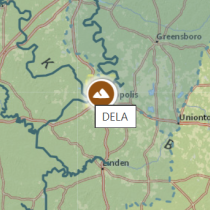Featured Expert: Paula Mabee on the Future of AI in Ecology
July 29, 2025
On June 16 to 18, over 40 participants, ranging from computer scientists to ecologists from U.S. universities, large corporations and research organizations, met at the University of Pittsburgh and associated venues around Pittsburgh at an NSF-funded workshop (NSF 2528520), “Cyberinfrastructure and AI for Ecological Research at NEON and Beyond” to discuss the value of AI in ecological research.
Pete Beckman, Professor at Northwestern University, and Justin Kitzes, Assistant Professor at the University of Pittsburgh, as well as Paula Mabee, Chief Scientist and Observatory Director of NEON, worked to set the stage for the attendees by fostering collaboration through self-led group discussions. The attendees, carefully selected for their expertise and interest in the topic, engaged in enthusiastic and wide-ranging discussions on the future applications of AI in ecology.
At the workshop, participants explored AI applications ranging from acoustic call signal recognition to adaptive sampling by mobile sensors. NEON, with its mission to provide long-term, high-quality ecological data across varied ecosystems, is positioned to serve as a critical testbed for AI.
Mabee sees real promise in integrating AI with NEON’s infrastructure. “NEON was built to scale ecological data collection,” she explained. “AI offers a chance to go further, enhancing remote monitoring, quality control, enabling image-based trait identification and preparing seasonal staff more effectively.”
Already, NEON is playing a key role in NSF’s cyberinfrastructure strategy, serving as the pilot testbed site for an NSF-funded $20 million edge-computing initiative, ‘Sage Grande’, led by Beckman (NSF 2436842).
Still, practical hurdles remain. Cost, equipment standardization, seamless data integration and continuity are key concerns. “AI can augment what humans do,” Mabee emphasized, “but it can’t necessarily replace it.”
Currently, NEON is piloting AI for projects such as preparing seasonal field staff for upcoming field work, including compiling information on what to pack and how to best organize ahead of travel to help them stay safe. The team is also testing AI to identify species’ traits by image to save staff time with taxonomy in the field in close collaboration with the NSF-funded Imageomics award (NSF 2118240), led by Tanya Berger-Wolf.
“NEON is committed to data quality and continuity,” Mabee said. “Incorporating AI means ensuring we don’t just add new tools, we integrate them in ways that are scalable at field sites from Alaska to Alabama.”
Looking three to five years ahead, Mabee anticipates that AI will become an integral part of NEON’s operations, particularly in real-time analysis and training.
“We’re not chasing tech for its own sake. We’re asking how it can make ecology more impactful,” said Mabee.
Learn more about NEON at www.neonscience.org.

